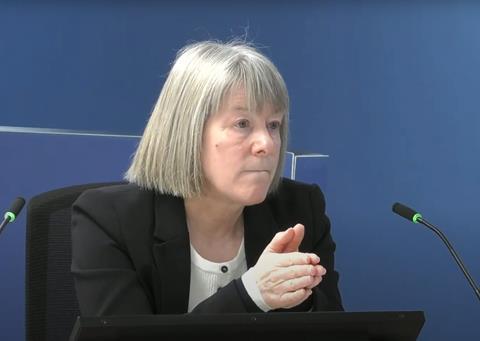Testing house’s former managing director admits lack of formal training regime was a ‘weakness’
Staff at the firm that tested the products used on Grenfell Tower’s cladding system may never have received impartiality training, the inquiry into the 2017 fire has heard.
Debbie Smith, former Building Research Establishment (BRE) managing director, told Wednesday’s hearing that training was “offered” but not recorded by a centralised register.
She said: “I suppose one of the weaknesses, I would have to say now, on reflection, is that we would not get people to sign in and sign out to that training, so there is the possibility that people never attended and did not receive that training.”
Phil Clark, former burn hall manager, has already told the inquiry that he never received any training from the BRE on how to remain independent and impartial when carrying out tests on building materials for commercial clients.
Clark oversaw the tests on insulation panels manufactured by Celotex, which the inquiry has heard were manipulated by adding non-combustible boards onto the test rig. Clark denied any knowledge of the boards, telling the inquiry that the “reliance was very much on the honesty of the client”.

Yesterday, Smith was asked by counsel to the inquiry Richard Millett QC if Clark had “slipped through the net” and did not attend impartiality training.
She said it was “possible”, adding that the training was not delivered at regular intervals and that staff were responsible for their own training logs.
Asked if she ever had concerns about how to safeguard impartiality in circumstances where the BRE was reliant on commercial testing as an income stream, Smith said she believed staff understood the need to remain independent and she was not “aware of anybody ever raising any particular flags or concerns around this”.
> Also read: Government published ‘confusing’ fire safety guidance, Grenfell Inquiry hears
The BRE, a former government laboratory set up in 1921, was privatised in 1997 and began commercial testing in 2000.
The inquiry has already heard that producing desktop studies for insulation maker Kingspan, which manufactured some of the panels used on Grenfell, was a “huge source of income” for the BRE in the years leading up to the fire.
Smith told yesterday’s hearing that the “stark reality” at the BRE is that the firm had to earn money or it would “cease to exist”.
The inquiry was shown a 2014 email from the Centre for Cladding and Window Technology (CWCT), an industry body which provides guidance on facades, inviting the BRE to discuss concerns over the use of combustible cladding and insulation on tall buildings.
When the email was forwarded to Smith, she replied to colleagues: “Wooooh! This looks very dangerous. We need to discuss our strategy to ensure that we don’t end up handing the fire safety mantle to CWCT (a competitor)”.
Smith told Millett that it was “very unusual” for her to respond in that way, but said that part of the issue was considering how much the BRE could collaborate with external bodies as “there was no income stream to cover this type of activity”.
Asked by Millett if the meaning of her email was that she did not want to lose a “competitive commercial edge” to the CWCT, Smith replied: “potentially that comes through as part of the point”.
Inquiry chair Martin Moore-Bick intervened, asking Smith: “One might get the impression that you were very concerned that CWCT was taking active steps to deal with a problem, and were concerned that it might be asserting its position in the market, which you’d found unwelcome. Is that a fair reading?”
Smith replied that might have been part of her “immediate reaction”.
Millett then asked if it was fair to say that Smith’s sole concern was to protect the BRE’s revenue streams and that she was not “interested in matters of public fire safety”.
Smith replied: “that was never my sole motivation in anything”.
Earlier in the day, Smith said she her reaction to discovering that building facades had been using combustible materials, a practice she believed had stopped after regulations were tweaked in 2006, had been one of “absolute shock”.
Asked when she discovered the truth, she said it had been in the aftermath of the Grenfell fire when it “became apparent as to what had been going on”.
The 2014 meeting with the CWCT, which was ultimately attended by BRE scientist Sarah Colwell, heard warnings from industry experts that combustible ACM panels were being widely used in tall buildings across the UK because of confusion over an ambiguous passage in building regulations.
Colwell agreed at the meeting that she would draft a frequently asked question (FAQ) clarifying the guidance for the government to publish on its website.
But the FAQ was never published, with Colwell telling the inquiry last week that it was not written because it was “assumed” that the existing guidance was going to be revised.
The inquiry continues.



























No comments yet